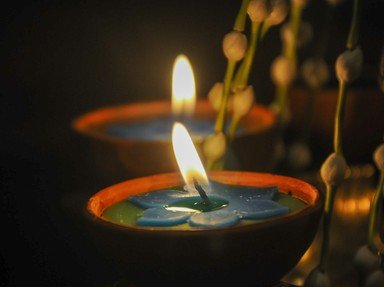Quiz Answer Key and Fun Facts
1. Is pure joy possible in this world, and in this day and age? This religion teaches that it isn't, and so a couple getting married will temper their joy with sorrow by breaking a wineglass at the climax of the ceremony. What faith is this?
2. Most Buddhists consider marriage to be a secular matter; it isn't a religious sacrament, as it is in many other faiths. However, it's always appropriate to cite religious guidance in a wedding ceremony. If a Buddhist couple derives their vows from the Digha Nikaya, a collection of sayings and sermons from the Pali canon, to what school of Buddhism do they likely belong?
3. Wedding ceremonies typically involve vows: solemn promises that the couple makes to each other, to society, and to the divine. Films and television shows have helped standardize one form of these vows, in which each person promises to take the other as a spouse, "to have and to hold from this day forward, for better for worse, for richer for poorer, in sickness and in health, to love and to cherish, till death us do part..." In what Christian book did these vows originate?
4. When a Muslim couple gets married, the groom is supposed to provide his bride with something called a mahr. Which of these best describes a mahr?
5. Zoroastrian weddings are filled with symbolism. Relatives might rub rock-sugar cones together to symbolize hopes for a life of sweetness; the families of the happy couple might plant saplings to represent fertility. At what time of day are Indian Zoroastrian weddings usually performed?
6. Pagan and Wiccan couples often solemnize marriages and betrothals in outdoor ceremonies, performed by a priestess and priest or by the couple themselves. The name for these rituals is taken from the common practice of binding together the couple's clasped hands, symbolizing their union. So tell me: what is the name for this kind of wedding?
7. At a Sikh wedding ceremony, the happy couple makes four circuits around the Guru Granth Sahib, while four sacred hymns are sung. Who or what is the Guru Granth Sahib?
8. You'll see a chuppah at just about any Jewish wedding, although one chuppah may be very different from the next. Which of these is the best description of a modern chuppah?
9. The specifics of a Hindu wedding often vary from region to region. One near-universal feature, however, is an homage to the god Agni. In this ritual, the couple walks seven times around what object?
10. In many faiths, readings from a holy book form a big part of a wedding ceremony. Sometimes, every wedding uses the same classics; sometimes, the couple chooses their favorites. The following quotation is from an extremely popular reading at weddings in which religious tradition?
"Love is patient, love is kind. It does not envy, it does not boast, it is not proud ... It always protects, always trusts, always hopes, always perseveres."
Source: Author
CellarDoor
This quiz was reviewed by FunTrivia editor
LeoDaVinci before going online.
Any errors found in FunTrivia content are routinely corrected through our feedback system.

